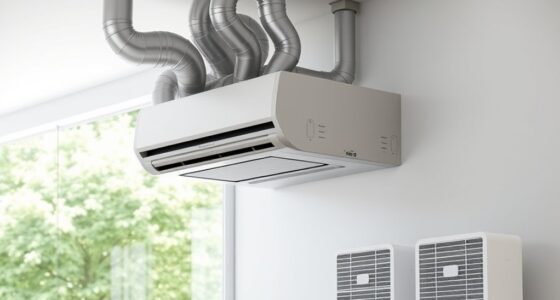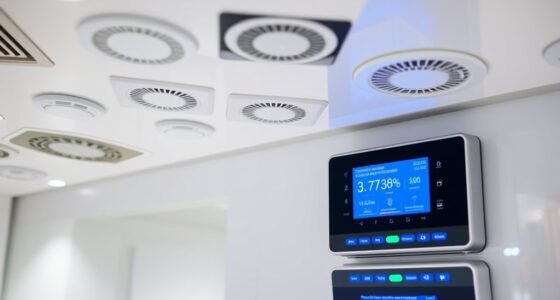IoT-enabled HVAC systems give you real-time air quality data and precise control, making indoor environments healthier and more comfortable. Sensors constantly monitor pollutants, CO2, humidity, and temperature, so your system can automatically adjust ventilation or air purification as needed. This proactive approach not only improves air quality but also reduces energy waste. If you want to discover how smart technology can optimize your climate and protect your health, there’s more to explore ahead.
Key Takeaways
- IoT HVAC systems constantly monitor air quality parameters like pollutants, allergens, and CO2 levels in real time.
- They automatically adjust ventilation and air purification to maintain healthy indoor air quality.
- Systems learn user preferences and occupancy patterns to proactively optimize climate and air settings.
- Real-time alerts notify users of air quality issues or equipment malfunctions for prompt action.
- Enhanced control and data collection improve system efficiency, reduce energy costs, and promote healthier indoor environments.

Internet of Things (IoT)-enabled HVAC systems are transforming how we manage indoor climate control by allowing devices to communicate and adapt in real-time. With sensors constantly monitoring air quality, temperature, humidity, and occupancy, these systems can make immediate adjustments that optimize energy efficiency and enhance user comfort. Instead of relying on static schedules or manual controls, you benefit from a dynamic environment that responds to your needs and the actual conditions inside your space. This means fewer energy wastages, as the system only operates at levels necessary to maintain ideal conditions, ultimately lowering utility bills and reducing your carbon footprint.
By integrating IoT technology, your HVAC system gains the ability to gather precise air quality data continuously. When pollutants, allergens, or excess CO2 are detected, the system can automatically increase ventilation or activate air purification, ensuring healthier indoor air. This real-time responsiveness not only improves air quality but also prevents the buildup of harmful substances, creating a safer environment for you and everyone inside. You won’t have to manually monitor air quality or guess when to open windows or adjust settings; the system does it for you, maintaining a consistently high level of indoor air health.
Your comfort is markedly enhanced because IoT-enabled HVAC systems learn your preferences over time. They analyze patterns in your behavior, occupancy, and environmental changes to personalize climate control. For instance, if you usually prefer a cooler room during the afternoon, the system can preemptively adjust the temperature before you even arrive home or start work. This proactive approach ensures that your space remains comfortable without unnecessary adjustments or energy use. Plus, remote access features allow you to control or monitor your HVAC system from your smartphone or other devices, so you can fine-tune settings even when you’re away.
Security and reliability also improve with IoT integration. These systems can send alerts if sensors detect unusual air quality issues or equipment malfunctions, allowing for prompt intervention. Over time, data collected helps optimize system performance and maintenance schedules, reducing downtime and costly repairs. You get peace of mind knowing your indoor environment is not only comfortable and clean but also managed efficiently and proactively.
Frequently Asked Questions
How Secure Are Iot-Enabled HVAC Systems From Cyber Threats?
IoT-enabled HVAC systems face cybersecurity risks that can compromise your data privacy and system functionality. While manufacturers implement security measures, vulnerabilities still exist, so you should stay vigilant. Regularly update firmware, use strong passwords, and enable encryption to protect your system. Being proactive helps minimize risks, ensuring your air quality data remains private and your HVAC system remains secure from cyber threats.
What Is the Cost Comparison Between Traditional and Iot HVAC Systems?
You’ll find that IoT-enabled HVAC systems typically cost more upfront than traditional ones, mainly due to technology and installation expenses. However, a thorough cost analysis shows that they often save you money long-term through increased energy efficiency and reduced maintenance costs. When comparing investments, IoT systems may seem pricier initially, but their ability to optimize performance and improve air quality can lead to significant savings and better indoor environments over time.
How Does Iot Improve Energy Efficiency in HVAC Operations?
You can cut energy waste by leveraging IoT, which is a game-changer. Smart zoning adjusts temperature in different areas based on occupancy, while predictive analytics forecast usage patterns to optimize settings. This proactive approach prevents overcooling or overheating, saving power and money. By acting before issues arise, you stay a step ahead, turning your HVAC system into an efficient powerhouse that reduces costs and minimizes environmental impact.
Can Iot HVAC Systems Integrate With Existing Building Management Systems?
Yes, IoT HVAC systems can integrate with your existing building management systems, but you might face interoperability challenges. These challenges stem from different protocols or standards that can hinder seamless system integration. To overcome this, make certain your IoT devices and BMS support common communication standards or consider using gateways that facilitate interoperability. Proper planning and choosing compatible technologies enable smooth integration, enhancing your building’s overall efficiency and control.
What Are the Maintenance Requirements for Iot-Enabled HVAC Systems?
Picture your smart HVAC system as a vigilant guardian, always tuned in. You need to regularly calibrate sensors to guarantee accurate air quality readings and perform firmware updates to keep it running smoothly. These tasks prevent glitches and maintain efficiency. By staying on top of sensor calibration and firmware updates, you ensure your system remains responsive, healthy, and ready to create a comfortable, safe environment around the clock.
Conclusion
By integrating IoT-enabled HVAC systems, you gain real-time air quality insights and smarter control. This technology helps you create healthier, more comfortable environments effortlessly. Remember, “Prevention is better than cure”—staying ahead with smart air management keeps your space safe and efficient. Embrace these innovations today, and you’ll enjoy cleaner air and peace of mind tomorrow. Don’t wait for problems to arise; take action now and breathe easier.










